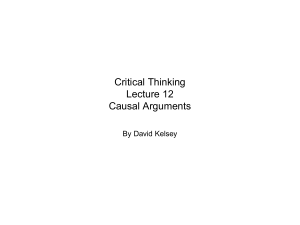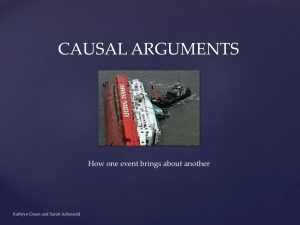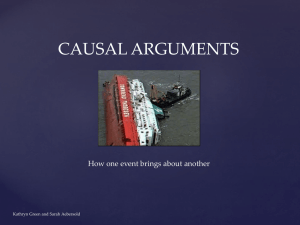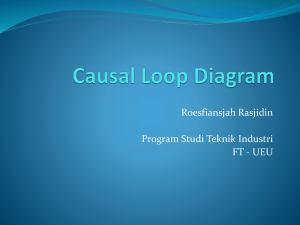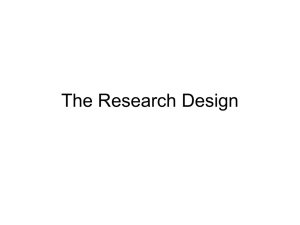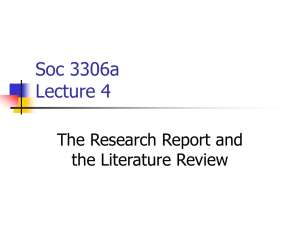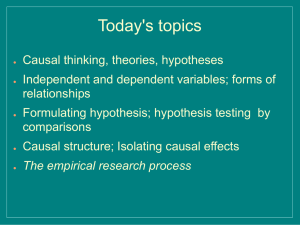Mind reading aliens: Causal forces and the Markov Assumption
advertisement
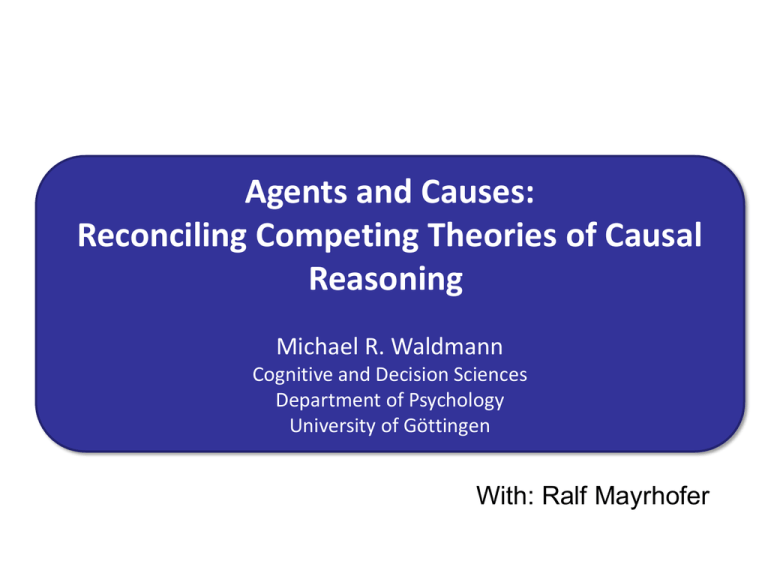
Agents and Causes: Reconciling Competing Theories of Causal Reasoning Michael R. Waldmann Cognitive and Decision Sciences Department of Psychology University of Göttingen With: Ralf Mayrhofer Overview 1. Causal Reasoning: Two Frameworks • Causal Bayes Nets as Psychological Models • • Overview of empirical evidence Markov violations in causal reasoning • Dispositional Theories • • Force dynamics Agents and patients 2. How Dispositional Intuitions Guide the Structuring of Causal Bayes Nets • • Experiments: Markov Violation Error attribution in an extended causal Bayes net Causal Reasoning: Two Frameworks Causal Models: Psychological Evidence • People are sensitive to the directionality of the causal arrow (Waldmann & Holyoak, 1992; Waldmann, 2000, 2001) • People estimate causal power based on covariation information, and control for co-factors (Waldmann & Hagmayer, 2001) • Causal Bayes nets as models of causal learning (Waldmann & Martignon, 1998) • People (and rats) differentiate between observational and interventional predictions (Waldmann & Hagmayer, 2005; Blaisdell, Sawa, Leising, & Waldmann, 2006) • Counterfactual causal reasoning (Meder, Hagmayer, & Waldmann, 2008, 2009) • Categories and concepts: The neglected direction (Waldmann & Hagmayer, 2006) • A computational Bayesian model of diagnostic reasoning (Meder, Mayrhofer, & Waldmann, 2009) • Abstract knowledge about mechanisms influences the parameterization of causal models (Waldmann, 2007) Causal Bayes Net Research: Summary „The Bayesian Probabilistic Causal Networks framework has stimulated a productive research program on human inferences on causal networks. Such inferences have clear analogues in everyday judgments about social attributions, medical diagnosis and treatment, legal reasoning, and in many other domains involving causal cognition. So far,research suggests two persistent deviations from the normative model. People‘s inferences about one event are often inappropiately influenced by other events that are normatively irrelevant; they are unconditionally independent or are „screened off“ by intervening nodes. At the same time, people‘s inferences tend to be weaker than are warranted by the normative framework.“ Rottman, B., & Hastie, R. (2013). Reasoning about causal relationships: Inferences on causal networks. Psychological Bulletin. Markov Violations in Causal Reasoning The Causal Markov Condition Definition: Conditional upon its parents (“direct causes”) each variable X is independent of all other variables that are not causal descendants of X (i.e., a cause “screens off” each of its effects from the rest of the network) 6 But recent research shows… • Recent research shows that human reasoners do consider the states of other effects of a target effect’s cause when inferring from the cause to a single effect (see Rehder & Burnett, 2005; Walsh & Sloman, 2007) vs. An Augmented Causal Bayes Net? Rehder & Burnett, 2005 The Causal Markov Condition: Psychological Evidence • Subjects typically translate causal model instructions into representation that on the surface violate the Markov condition. • Humans seem to add assumptions about hidden mechanisms that lead to violations of screening-off, even when the cover stories are abstract. • It is unclear where the assumptions about hidden structure come from. People typically have only sparse knowledge about mechanisms (Rozenblit & Keil, 2002). Dispositional Theories Abstract Dispositions, Force Dynamics, and the Distinction between Agents and Patients • Causation as the product of an interaction between causal participants (agents, patients) which are endowed with dispositions, powers, or capacities. – e.g., Aspirin has the capacity to relieve headaches. Brains have the capacity to be influenced by Aspirin. • Agents (who don‘t have to be humans) are the active entities emitting forces. Patients are the entities acted upon by the agents. Patients more or less resist the influence of the agents. • Intuitions about abstract properties of agents and patients may guide causal reasoning in the absence of further mechanism knowledge. Wolff’s Theory of Force Dynamics (Wolff, 2007) Cause Allow (enable) Prevent Patient tendency for endstate Affector (i.e., agent)patient concordance No No Yes Yes Yes Yes Yes No No Endstate approached Examples „Winds caused the boat to heel“ (cause) „Vitamin B allowed the body to digest“ (allow) „Winds prevented the boat from reaching the harbor“ (prevent) Problems • Where does the knowledge about tendencies come from if covariation information is excluded? • How can predictive and diagnostic inferences within complex causal models be explained? • How do we know whether a causal participant plays the role of an agent or patient? How Dispositional Intuitions Guide the Structuring of Causal Bayes Nets Hypotheses 1. Both agents and patients are represented as capacity placeholders for hidden internal mechanisms. 2. There is a tendencyEE.g., to blame the agent to a large extent for both successful and unsuccessful causal transmissions. 3. These intuitions can be represented by elaborating or re-parameterizing the causal Bayes net. Experiments: Markov Violation An Unfamiliar Domain: Mind Reading Aliens (see also Steyvers et al., 2003) POR=food (in alien language) Dissociating Causes and Agents I. Cause Effect Agent Patient EE.g., II. Cause Effect Patient Agent Manipulating the Agent Role 1. Sender Condition (Cause Object as Agent) „Gonz is capable of sending out his thoughts, and hence transmit them into the heads of Murks, Brrrx, and Zoohng.“ Gonz 1. Reader Condition (Effect Objects as Agents) „Murks, Brrrx, and Zoohng are capable of reading the thoughts of Gonz. “ Murks Brrrx Zoohng Experiment 1a: Which Alien is the Cause? (Intervention Question) 10 Probability of "POR" 9 8 Reading 7 Sending 6 5 4 3 2 1 0 Cause Effect Imagine „POR“ was implanted in head of cause/effect alien. How probable is it that the other alien thinks of „POR“. Experiment 1b: Blame Attributions 100 Blame Attributions (in %) 90 80 70 60 Cause Effect 50 40 30 20 10 0 Reading Sending Who is more responsible, if cause is present and effect absent, the cause alien or the effect alien? Markov Violations: Experiment 2 Instruction: 4 aliens either think of POR or not; thoughts of pink top alien (cause) covary with thoughts of bottom aliens (effects); aliens think of POR in 70% of their time. ? Test Question: “Imagine ? ? 10 situations with this configuration. In how many instances does the right alien think of POR?” Predictions Gonz ? Murks Sender Condition: The pattern seems to indicate that something is wrong with Gonz‘s capacity to send. Hence, the probability of Murks having Gonz‘s thought should be low (i.e., strong Markov violation). Reader Condition: The pattern seems to indicate that something is wrong with Brrrx‘s and Zoohng‘s capacity to read. Hence, the probability of Murks having Gonz‘s thought should be relatively intact (i.e., weak Markov violation). Results: Experiment 2 ? 10 9 8 7 ? 6 5 4 3 2 1 0 F=0 F=1 F=2 Error attribution in an extended causal Bayes net Error attribution in causal Bayes nets Standard Model: C wC E Stan 15 Distinguishing between two types of error sources Differentiating between Cause (FC)and Effect (FE)-Based Preventers: FE FC C E Simplified Version: FC C wC E 15 Error Attribution in a Common Cause-Model C FC wC E1 E2 … En • FC is an unobserved common preventer, and must be inferred from the states of C and its effects • When C involves the agent, the strength of FC is high (i.e., error is mainly attributed to C), when E involves the agent, the strength of FC is low (hence errors are primarily attributed to the individual effects (i.e., FE, that is, wC). 15 60 80 The strength of the FC (red – green – blue) influences the size of the Markov violation (i.e., slope). 40 E3 20 E2 CC=0 CC=1 wF_C beta(1,1) beta(5,1) beta(100,1) 0 C E1 inference rating FC 100 Model Predictions 0 1 2 # of observed effect features being on 17 Further Predictions (1): A/B Case ? • In the basic experiments an asymmetry between the two states of the cause was found • In the absent case the cause is not active, thus mechanism assumptions cannot have an influence • Prediction: When both states of the cause are described as active, the differential assumptions about error attribution should matter in both cases 18 Markov-Experiment A/B: Results ? 10 9 8 7 ? 6 5 4 3 2 1 0 NE0 NE1 NE2 N=56 19 Further Predictions (2): Causal Chains ? IC1 FC IC2 FC DC FC E • If each C comes with its own FC, the difference between reading and sending conditions should completely disappear in a causal chain situation 20 Chain Experiment: Results ? 10 9 8 7 ? 6 5 4 3 2 1 0 0/2 1/1 2/0 N=50 21 Summary • Causal model instructions are typically augmented with hidden structure. • In the absence of specific mechanism knowledge intuitions about abstract dispositional properties of causal participants guide the structuring of the models.


